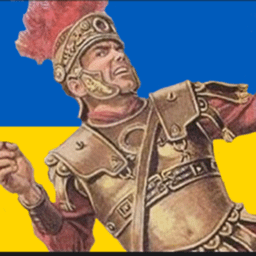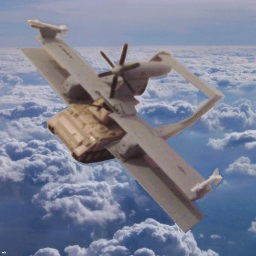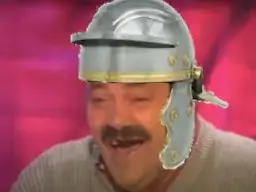Cripple. History Major. Irritable and in constant pain. Vaguely Left-Wing.
- 1.6K Posts
- 1.03K Comments

“Ho, Tom Bombadil, Tom Bombadillo!”

 10·20 hours ago
10·20 hours agoExplanation: The Terracotta Army is a set of funerary sculptures depicting soldiery buried with the first Emperor of China. Wargame enthusiasts might also recognize the desire to collect models of soldiers en masse.

 5·20 hours ago
5·20 hours agoExplanation: The Terracotta Army is a set of funerary sculptures depicting soldiery buried with the first Emperor of China. Wargame enthusiasts might also recognize the desire to collect models of soldiers en masse.

 2·1 day ago
2·1 day agoBased
Just a handful before heading off to the ziggurat

 8·2 days ago
8·2 days agoThe truth always endures. It’s durumable.

 17·2 days ago
17·2 days agoExplanation: “Goths” in the modern day are people of a specific aesthetic subculture.
“Goths” in the 4th century AD were a roving group of Germanic tribes which, at various times, allied with and against the Roman Empire.

 13·3 days ago
13·3 days agoImmensely based gardener.

 5·3 days ago
5·3 days agoFuck me, fixed it. It’s Martial, not Juvenal, I was mistaken.
In omnibus Vacerra quod conclavibus
Consumit horas et die toto sedet,
Cenaturit Vacerra , non cacaturit.
Epigrams, Book 11, Epigram 77
A poetic translation being given as
In privies Vacerra consumes the hours;
the whole day does he sit;
Vacerra wants to dine,
he does not want to shit

 4·4 days ago
4·4 days agoOther way around - vinegar was used in food first. Seems someone decided at some point they’d rather the butt-sponge smell like vinegar than butt.

 8·4 days ago
8·4 days agoThe sponge-stick was stored in vinegar or salt-water, but fermented urine was used for cleaning clothing!

 13·4 days ago
13·4 days agoAs the latrine situation implies, Romans were not very privacy-oriented! To the point that Julius Caesar, of dictator and conqueror fame, was considered somewhat weird because he read silently, in his head, rather than out loud. It seemed furtive and secretive to the Romans, for whom almost everything was an affair to be shared!

 9·4 days ago
9·4 days agoDo we know for certain they actually wiped with the sponge?
Fairly certain. There are alternate theories, but the most accepted one is still that the sponge was used for wiping.
A sponge-on-a-stick having better reach from the seated position than a small jug, and no risk of breaking upon dropping nor theft.
… sponge-on-a-stick feels pretty stealable, at least as much as a jug. Wealthier folk would sometimes have a slave carry a personal ass-sponge for them in case they had to use the public latrines while out, which seems, to me, also to point towards the ass-wiping interpretation.
I feel like the disgust at the idea of smearing feces between strangers would be just as strong 2000 years ago as it is today.
-
You would be surprised at what different standards the past had. The Romans, indisputably, swished urine to whiten their teeth. And not their own urine either.
-
Hygiene, in general, was not viewed as strictly as we do in the modern day. Obsessive hygiene is a product of the mid-late 19th century AD and germ theory, and even then, it took quite some time to catch on in the general population. There’s a short satirical poem(? if memory serves) in the time of the Roman Empire making fun of a guy who shows up to the bath-house with an unwashed ass. While this shows that such a thing was unusual and worth mocking, it also shows that it’s the kind of thing that could happen. You may be sharing ass-water with a guy in the public baths, it’s just life.
-
You are supposed to give it a good rinse.
-

 3·4 days ago
3·4 days agoCringe hyper-aristocratic caste-based mega-slaver militarized totalitarian state 🤢
Based gay-married citizen-volunteers for democratic hegemony 😍

 22·4 days ago
22·4 days agoOn one hand, a lot of trivia like this you have to sit back and say, “Well, they didn’t do too bad, with what they had.”
And on the other hand, you have to cringe hard and feel thankful you live in the modern day. No shared butt-sponge for me, thank you!

 6·4 days ago
6·4 days agoThe US Navy had some 700 warships by the end of the Civil War, which was about the size of the British Navy, if memory serves. While the British navy almost definitely had more large ships, 700 is a sizable force no matter how you slice it, short of them all being a guy in a canoe with a punt gun.
I haven’t even read Mahan.
I haven’t either tbf, lol

 28·4 days ago
28·4 days agoDefine ‘cleaned’?
That channel in front of the latrines would be used to give the sponge a rinse between uses; after a user was done wiping, they’d put it back into a bucket full of salt water or vinegar (or some mixture thereof).
In any case, it’s a great way to pass along parasites. 😬

 15·4 days ago
15·4 days agoHermogenes, it seems to me, Ponticus, is as great a thief of napkins as Massa was of money. Even though you watch his right hand, and hold his left, he will find means to abstract your napkin. With like subtilty does the breath of the stag draw out the cold snake; and the rainbow exhale the waters from the clouds. Lately, while a respite was implored for Myrinus, who had been wounded in a conflict, Hermogenes contrived to filch four napkins. Just as the praetor was going to drop his white napkin, to start the horses in the circus, Hermogenes stole it. When at last nobody brought a napkin with him, for fear of thefts, Hermogenes stole the cloth from the table.
And should there be nothing of this kind to steal, Hermogenes does not hesitate to detach the ornaments from the couches, or the feet from the tables. However immoderate may be the heat in the theatres, the awnings are withdrawn when Hermogenes makes his appearance. The sailors, in trembling haste, proceed to furl their sails whenever Hermogenes shows himself in the harbour. The bareheaded priests of Isis, clad in linen vestments, and the choristers who play the sistrum, betake themselves to flight when Hermogenes comes to worship.
Hermogenes never took a napkin to dinner; Hermogenes never came away from a dinner without one.






7, wishing I was 2